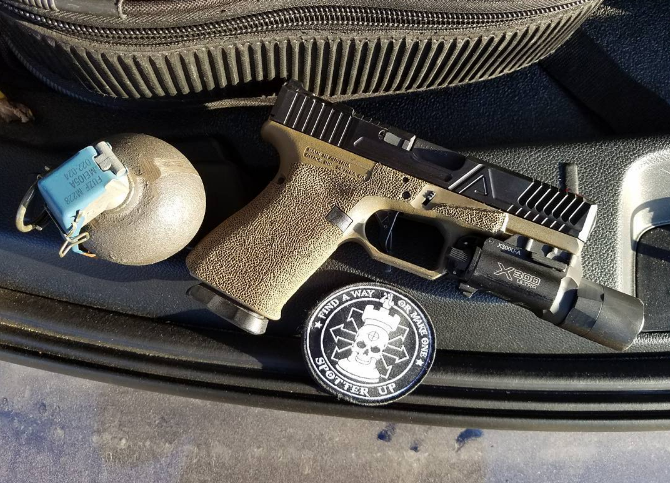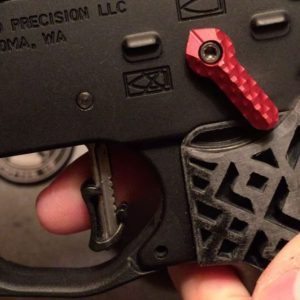In this shooting tip, I just want to discuss the shooting flinch and how you can alleviate it, if only temporarily. We have all embarrassed ourselves in front of our friends or strangers by pulling the trigger on a rifle or pistol and jolting it forward on an empty chamber or a dud round. Heck, I still have that issue to this day at times.
Sometimes it is the result of recoil anticipation and applying corrective force to get back on target and fight the recoil. Then there are other times when it is from getting that last minute grip which causes your rounds to go flying off your intended point of impact. The former is not so much of an issue for the shooter, but it can be a sign of not having a stable stance, grip, or position.
Sometimes we can not make everything about our shooting platform perfect, but you should be ready to cross the bridge when you come to it instead of preparing for living on the bridge. In other words, just because you won’t always have a stable stance doesn’t mean you should forego setting up one when you can. A stable stance when shooting a rifle can stabilize the weapon a lot better than you realize. But there are ways to condition yourself to get over the dreaded shooting flinch, no matter the source.
CAUSING THE MISS
As I stated earlier, there are a number of reasons for a flinch. But the big thing to remember is that it is all rooted in the mind. Most of the mental energy behind the flinch is rooted around preventing and controlling recoil. We as human beings like to have control of everything we do because we are natural control freaks. It is unnatural for us to purposely do something that would harm us or put us off-balance like letting recoil run its’ course. Kinda like when you are driving, you will see that you naturally lean forward if you step on the gas and nothing happens. I have had this happen when I was driving a manual and didn’t put my vehicle in gear.
The fear of recoil is typically fought by altering triggers to make them go off with little effort, giving the illusion that you are a better shooter with it.
In reality this just points to a flaw in your mental state and fear of the gun. This is not a solution, but a patch, like drinking to get over your problems.
Another common solution people seem to try is something called the “now shot.” This is where you just yank the trigger in order to get the shot over with before the anxiety builds too much. This is common when precision shooting, no matter the trigger weight.
Your brain somehow thinks that this jerking motion will somehow beat your natural instinct to get complete control or counteract the recoil. This typically results in a deviation from your intended shot placement anyways because you end up using other muscles that just your trigger finger in order to deliver the shot quick enough.
People can get all the fancy gear they want in order to work around their fear of recoil. In the end, the cause of the shooting flinch is not going to be fixed by spending money on gear marketed to make you a better shooter. When 90% or your misses are caused by flinching, that is a sign that you need to build good habits, not cater to your bad ones. This can be done for free.
BUILDING GOOD HABITS
Learning to shoot is more complicated than many pros make it look. It takes discipline and a stubborn attitude to perfect or even become mildly proficient. Not to mention that it takes an individual being able to analyse themselves and have a high degree of self-awareness at all times.
Many experienced shooters can call their shots before they even see their impacts. This is because they fine tune their senses to the correct way of shooting and condition themselves to doing things right. It almost becomes an obsession for me because I tend to be a perfectionist in most things I do. I often use the saying “If you’re gonna do it, do it right.”
Many professionals and avid shooters use dry fire practice as one of their training tools. It is arguably the most effective training tools out there depending on what the goal is. We all know that repetition builds habits, whether they are good or bad.
Dry firing with snap caps and just practicing manipulation in general is a good way to condition yourself to do things right every time. Only using live ammo to practice not only robs you of the chance to adopt proper fundamentals for free, but you could be enforcing bad habits by constantly repeating them without even realizing it. The shooting flinch is probably the most common bad habit.
Think about how the military churns out competent and adaptive shooters by the thousands for the past couple centuries. It isn’t from some downloaded skill or endless ammo and time behind the gun. I shot more in my first month out than I did during my whole time in military training as a grunt.
It was through repetition; good old dry fire and repetition in crappy conditions. Wet, tired, aching, anxious are common conditions we found ourselves in when being instructed. All the odds are against you to the point that a calm day at the range helps you pool all the experience you gathered when you had to find a way to maintain good marksmanship principles, no matter the conditions.
There are many tools these days that can help a serious or recreational shooter become more proficient. No matter what tools you use, there is no substitute for good old physical repetition. As with walking and learning any fine motor skill like writing, going through the motions is the best way to learn how to do that activity better.
Dry firing lets you do it for free and can be the best way to diagnose any bad habit that needs to be corrected. Using the gun you are going to use is also a good thing to do. of course you can always step up to something that requires more strength and fine tuning such as a double action. I found that the double action is like a manual transmission, once you learn it, everything else is easy to use.
BUILDING CONFIDENCE
Most of the flinching and horrible fliers can be attributed to the shooter anticipating and even fearing the recoil. When you learn how to shoot for the first time in a class, most instructors will have you start very close to the target in order to build your confidence. This is a very good philosophy, but I have found that something else can be just as beneficial at building confidence that will help you overcome the fear of recoil.
I have found that having the person shoot fast is a very good way to calm their nerves and get more in tune with the guns recoil characteristics. One round for marksmanship is just asking for trouble when you have a new shooter who can’t help but be fearful that their grip is not sufficient enough to prevent the gun from jumping uncontrollably. When a shooter can analyse recoil and see how much it jumps around, they can find a way to control it.
With shooting fast, we can eliminate the fear of the unknown. I have seen it several times in classes where new shooters hit almost perfectly when they draw and shoot fast. The more time you take to apply the fundamentals, the longer you have to rethink your actions and second guess yourself. Of course, using good habits like dry fire practice will help you advance to making hits. But I have noticed that people learn a lot by shooting the guns fast while still trying to make a hit.
The fear of recoil is very apparent when a shooter uses a gun that recoils more like a .308 or a .40 cal, and then transitions to a 9mm. The FBI even found this out and decided hire qualification scores on paper is a good enough justification for completely changing their armories to host the 9mm after so much investment in the .40 cal.
FINAL THOUGHTS
My overall goal in shooting is to perfect the gun and make that perfect shot second nature. That is a shared goal by most avid shooters I am sure. Perfection is a goal that is nearly impossible to obtain, but it gives us mortals a purpose and drive that is everlasting. You may never completely eliminate the shooting flinch. But you can surely combat it and make it an uncommon occurrence. Never give up and remember that it is always on you to “Find a way, or Make one.”
*The views and opinions expressed on this website are solely those of the original authors and contributors. These views and opinions do not necessarily represent those of Spotter Up Magazine, the administrative staff, and/or any/all contributors to this site.


*higher